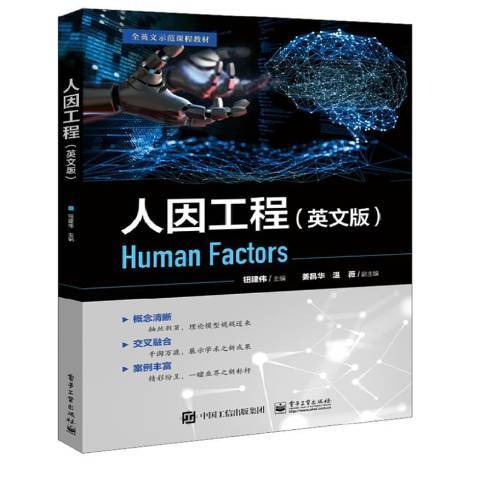《人因工程》是2021年電子工業出版社出版的圖書。
基本介紹
- 中文名:人因工程
- 作者:鈕建偉
- 出版社:電子工業出版社
- 出版時間:2021年
- 開本:16 開
- ISBN:9787121407734

《人因工程》是2021年電子工業出版社出版的圖書。
人因工程學是一門新興的正在迅速發展的交叉學科,涉及多種學科,如:生理學、心理學、解剖學、管理學、工程學、系統科學、勞動科學、安全科學、環境科學等,套用領域十分廣闊。因此,在本學科的形成和發展過程中,各學科、各領域、各國家...
《人因工程》是2011年科學出版社出版的圖書,作者是孫林岩、崔凱、孫林輝。內容簡介 本書分為概述、基礎篇、拓展篇三部分,概述了人因工程的基礎、經典理論、知識和方法,並對人因工程的主要套用領域,即人因安全、可用性、人員測評、...
《人因工程學》除可作為高等院校工業工程專業必修課的教材外,也可作為其他產品類專業的必修課教材或選修課的教學參考書,還可供人因工程學相關方面的研究人員和工程技術人員參考。內容簡介 本書系統地闡述了人因工程學的理論與研究方法...
《人因工程》是2011年北京大學出版社出版的圖書,作者是馬如宏。這本書系統地介紹了人因工程的基本原理和影響作業效率的人、環境與機器系統的互動作用。內容簡介 《人因工程》系統地介紹了人因工程的基本原理和影響作業效率的人、環境...
《人因工程(第二版)》是科學出版社出版的圖書,作者是蔡啟明,劉文杰。 內容簡介 本書系統介紹了人因工程的基本原理和影響生產生活效率的人、環境與人機系統的互動作用。全書分為概述、基礎篇、套用篇和擴展篇四大部分,共12章。概述...
《人因工程學》是2006年機械工業出版社出版的圖書,該書作者是郭伏。內容簡介 本書從生產(或服務)和管理系統最佳化角度闡述了有關人因工程學思想、理論和方法。突出闡述了系統設計中人的因素的重要性。對人的生理、心理特點,作業能力、...
《人因工程》是2021年電子工業出版社出版的圖書。內容簡介 人因工程是通過人-機-環境系統最佳化來達到提高系統生產率,保證人健康、安全、舒適工作的學科。本書作者集十多年從事人因工程教學科研的實踐經驗,根據人因工程的*發展趨勢,突出...
主控室人因工程內容 包括主控室功能分配、布置、環境、信息系統,以及人體工程學等方面。主控室功能分配 在核電廠正常、異常及事故運行時主控室所履行的功能分析的基礎上,進行功能分配,分配給操縱員的任務應適度。分配時要考慮到負荷量、...
《人因工程設計及精彩案例解析》是一本2020年化學工業出版社出版的圖書,作者是唐智,黃波等。本書介紹了人因工程學的基本概念和相關理論,並用相關案例說明理論的運用方法。內容簡介 本書介紹了人因工程學的基本概念和相關理論,並用...
人因工程學是東北大學於2017年10月16日首次在中國大學MOOC開設的慕課課程、國家精品線上開放課程。該課程授課老師是郭伏、金海哲。據2020年9月中國大學MOOC官網顯示,該課程已開課6次。該課程理論課程部分和實驗課程部分,理論課程部分共14...
中國人因工程高峰論壇由中國航天員科研訓練中心人因工程國家級重點實驗室倡議發起。歷屆論壇 第一屆 舉辦時間:2016年4月9日-10日 舉辦地點:深圳 主辦單位:深圳市科學技術協會、深圳市福田區人民政府和中國航天員科研訓練中心 論壇主題...
人因工程-因人而設課程是西安交通大學建設的慕課,國家級精品課,於2015年秋冬在智慧網開設。該課程的授課教師為劉樹林、賈濤、吳鋒。據2021年8月智慧樹官網顯示,該課程已運行13學期,累計選課2.61萬人、累計學校221所、累計互動7.27...
《人因工程學導論》是2007年華東師範大學出版社出版的圖書,作者是威肯斯。內容簡介 本書是關於研究“人因工程學導論”的專著,具體包括了:人因學簡介、視覺感覺系統、人體測量學與作業空間設計、人與計算機互動作用、人員的選拔與培訓、...
《人因工程設計》是2006年4月1日化學工業出版社出版的圖書,作者是鄭午。本書結合實例按照循序漸進的方式,對CATIA V5的Ergorlomlcs Design & Analysis(人因工程設計和分析)單元中的相關模組進行了詳盡的介紹。內容簡介 人因工程學是...
《人因工程:基礎與實踐》是2013年10月中國人民大學出版社出版的圖書,作者是饒培倫。內容簡介 全書分為16章內容,包括人體計測與作業區域設計、人工物料搬運設計、視覺感官系統、聽覺感官系統及噪音振動、人員信息處理與心智負荷、控制器...
《人因工程學與設計套用(普通高等教育藝術設計類專業規劃教材)》是2013年化學工業出版社出版的圖書,作者馬廣韜。運用了人因工程學的基本原理,分析了設計中人的因素和環境因素,並將人的因素和環境因素的研究融八到了室內設計、室外環境...
中文名稱 [核電廠主控室]人因工程 英文名稱 humanfactorengineering[ofnuclearpowerplantmaincontrolroom]中文名稱:[核電廠主控室]人因工程;英文名稱:humanfactorengineering[ofnuclearpowerplantmaincontrolroom];定義1:研究核電廠中人機...
《人因工程實驗》是2014年華東理工大學出版社出版的圖書,作者是吳慧蘭。內容簡介 《人因工程實驗》可作為高等院校工業設計、藝術設計、機械工程、工業工程、管理科學與工程等學科(專業)的教學用書;還可作為各類工程技術人員、管理人員的...
《人因工程學(第2版)》是2019年9月機械工業出版社出版的圖書,作者是郭伏、錢省三。 內容簡介 本書從生產(或服務)和管理系統最佳化角度闡述了有關人因工程學思想、理論和方法。突出闡述了系統設計中人的因素的重要性。對人的生理...
《人因工程概論》是2023年電子工業出版社出版的圖書,作者是湯曉穎、夏天生、宋文芳。內容簡介 本書以人因工程在設計類專業領域的原理和套用為主要內容,共 8 章。第 1 章主要介紹人因工程的科學緣起,讓讀者對人因工程的概念、內涵、...
清華大學複雜系統人因工程研究中心致力於提高複雜工業系統的操作安全性和效率,將人的因素納入到工程設計、實施與運營管理中,面向航空、航天、核電站、高鐵、船舶、軍工裝備等安全關鍵的領域,以實際問題為導向,開展技術研究與套用、項目...
《人因工程:從人機相宜到人機合一》是一本2023年機械工業出版社出版的圖書,作者是方衛寧,陳悅源 等。內容簡介 本書主要從工程套用角度介紹工程與設計中的人因工程學問題,全書共6章。第 1 章講述了人因工程學科的歷史起源與演變。第...
人因工程大綱評審模式指利用《人因工程項目評審大綱》作為指導性檔案對運營單位人因工程進行評審的模式。在核電廠的建設和運行過程中,運營單位必須保證在人因工程項目中所參考的人因工程導則和準則是行業所接受的,從而確保核電廠的安全性...
《人因工程基礎與案例》是2008年1月7日化學工業出版社出版的圖書。內容簡介 本書是《工業工程教育叢書》之一。本書以人因工程的主要理論為基礎,介紹了大量的具有代表性、典型意義的人因工程套用案例,突出反映人因工程的實踐性、綜合性...
2011年3月29日我國首個人因工程國家重點實驗室在中國航天員中心揭牌。該實驗室的成立,將進一步推動人機互動理論研究,為我國載人航天工程發展提供理論依據和技術支撐。主任陳善廣院士。簡介 人因工程是一門新興交叉學科,著眼解決“為人使用...
是指個體差異在人因工程學上的表現,包括主觀和客觀兩方面因素。主觀因素有粗心大意、理解能力、判斷能力、記憶能力、急躁情緒、僥倖心理、虛榮心理;不良作風、安全意識、技術水平、操作能力、身體素質及心理素質等。客觀因素有無章可循、...
《人因工程學(上)》是北京理工大學提供的慕課課程,授課老師是薛慶、劉敏霞、蔣曉蓓。課程大綱 01 第一章 人因工程學概述 了解人因工程學,特別是其研究領域。課時 1.1什麼是人因工程 1.2人因工程學的形成與發展 1.3人因工程...
《人因工程基礎與設計》是2010年出版的圖書,作者是孫遠波。內容介紹 《人因工程基礎與設計》按人的因素基礎、人因工程設計基礎、人因工程與產品設計三部分編寫。輔以設計實例分析。重點介紹設計原理的套用。針對工業設計和機械設計教學,由...
人因工程實驗系統是一種用於機械工程領域的醫學科研儀器,於2014年12月22日啟用。技術指標 同步採集人類行為、動作、腦電、眼動、生理、生物力學以及物理環境數據,人機環境同步實時記錄模組可以實現實時以及事後兩種同步方案,並且實時可視化...
工效學也稱人因工程學或人機工程學,是指綜合運用生理學、心理學、衛生學、人體測量研究生產系統中人、機器和環境之間的相互作用的一門邊緣科學。其通過對作業中人體機能、能量消耗、疲勞程度、環境與效率的關係等研究,科學地進行作業環境...
